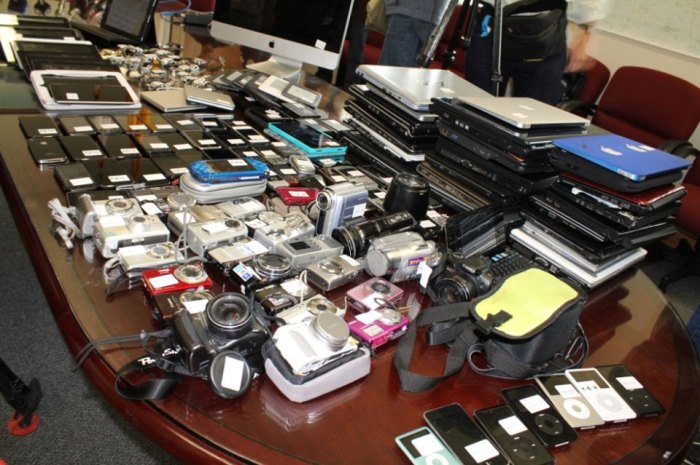The shadowy world of fence for stolen goods operates at the intersection of crime and commerce, where illicit goods find a covert path to the market. Fences, the gatekeepers of this clandestine network, play a pivotal role in concealing the origins of stolen property and facilitating its sale, often with devastating consequences for individuals, communities, and the economy.
Their modus operandi involves a web of deception and subterfuge, from acquiring stolen goods through illicit channels to disguising their provenance and ownership. Fences employ cunning strategies to evade detection and prosecution, making their apprehension a daunting task for law enforcement.
Definition and Purpose: Fence For Stolen Goods

Fencing for stolen goods refers to the illegal trade and distribution of stolen property. Fences act as intermediaries, acquiring stolen goods from thieves and selling them to unsuspecting buyers in the black market.
Fences play a crucial role in the black market economy, providing a channel for criminals to dispose of stolen items while obscuring their origins and ownership.
Stolen goods commonly handled by fences include electronics, jewelry, art, vehicles, and designer clothing.
Modus Operandi
Fences employ various methods to acquire stolen goods, including:
- Direct purchase from thieves
- Acting as middlemen in transactions between thieves and buyers
- Infiltrating legitimate businesses to launder stolen goods
Fences conceal the origin and ownership of stolen goods through techniques such as:
- Altering or removing serial numbers or identification marks
- Creating false documentation
- Using straw buyers to purchase stolen goods
To avoid detection and prosecution, fences may use aliases, operate from multiple locations, and engage in counter-surveillance measures.
Impact on Society

Fencing has severe consequences for individuals and communities:
- Victims of theft suffer financial losses and emotional distress
- Stolen goods can be used to commit other crimes
- Fencing undermines trust and community safety
Economically, stolen goods impact businesses and the economy:
- Businesses lose revenue due to theft
- Consumers may purchase stolen goods unknowingly, contributing to the black market
- Fencing can distort market prices and promote unfair competition
Fences also contribute to crime and undermine public safety:
- Stolen goods provide financial incentives for theft
- Fences may engage in violence or intimidation to protect their operations
- Fencing can facilitate the flow of illegal weapons and other dangerous items
Legal and Enforcement Considerations, Fence for stolen goods
Fencing is a criminal offense with varying penalties depending on the jurisdiction and value of stolen goods.
Law enforcement faces challenges in combating fencing activities due to:
- Fences’ use of sophisticated concealment methods
- Difficulty in identifying and locating fences
- Lack of cooperation from victims and witnesses
Current laws and enforcement strategies have varying degrees of effectiveness in deterring fencing:
- Stricter penalties may deter some fences but may also lead to increased violence
- Increased surveillance and undercover operations can disrupt fencing activities
- Community involvement and education can raise awareness and reduce demand for stolen goods
Prevention and Mitigation

Reducing the prevalence of fencing requires a multifaceted approach:
- Community engagement and education to discourage theft and the purchase of stolen goods
- Improved security measures to make theft more difficult
- Innovative technologies, such as GPS tracking and item registration, to aid in recovery of stolen goods
Collaboration between law enforcement, community organizations, and businesses can enhance prevention and mitigation efforts.
FAQ Insights
What is the role of fences in the black market?
Fences act as intermediaries between thieves and buyers of stolen goods, providing a safe haven for illicit trade and obscuring the origins of stolen property.
How do fences conceal the origin and ownership of stolen goods?
Fences employ various methods to disguise the provenance of stolen goods, including altering serial numbers, forging documents, and laundering items through legitimate businesses.
What are the challenges faced by law enforcement in combating fencing activities?
Law enforcement faces difficulties in apprehending fences due to their covert operations, lack of physical evidence, and the complexity of tracing stolen goods through multiple transactions.
